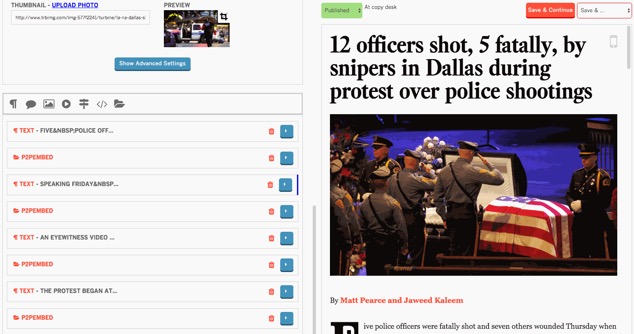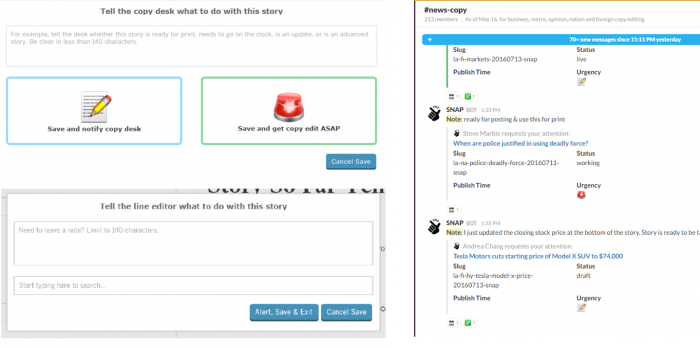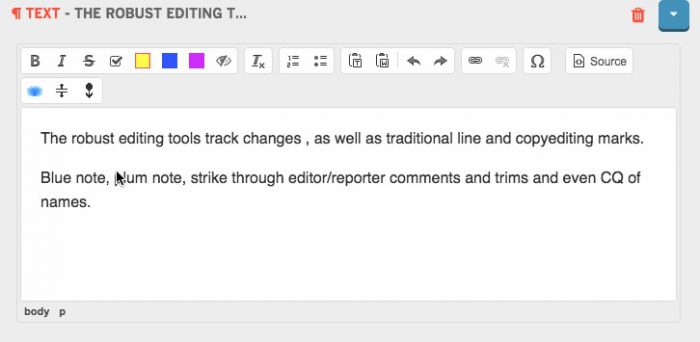
Not a lot of hands up? The Los Angeles Times is trying to get a little closer to that magical place. Its new story editor SNAP (for Simple News Assembly Platform), built primarily by two dedicated Times staffers, is by all accounts really a product created by and for a newsroom, and it will soon start rolling out to the rest of Times parent company Tronc’s other markets, replacing a clunky legacy editing system1 The San Diego Union-Tribune, which Tronc acquired in 2015, will be getting SNAP in September, and then likely the Florida papers, though the rest of the rollout order is still being worked out.
“The newsroom had felt really disconnected from the tech side, and it was refreshing I think for them to have input,” said Times data desk staffer Evan Wagstaff, one of SNAP’s builders.
SNAP 1.0, fully in use in the Times newsroom, is already chock full of features designed to speed up the time between writing and publishing online — and simplifies the process of exporting stories to the print production software NewsGate to a click of a button. SNAP is a WYSIWYG editor that is simpler to compose in, and, unlike the legacy P2P content management system the newsroom was relying on before, can handle an extensive edit trail, from reporter and editor strikethroughs and comments to CQ notes. SNAP uses Slack authentication, and workflow alerts go straight into the popular workplace chat app. (If you’re interested: SNAP uses Backbone.js, JQuery, and RequireJS on the front end and Flask on the server side.)

It’s easier to add video elements, quotes (a multi-part process in the old system), tweets, to incorporate HTML where needed. It’s loaded up with a range of templates tailored to the needs of different desks (sports, for instance will often want a highlight reel, so the sports story template will include one) to spare web producers from some of the busy work.

SNAP grew from smaller projects. In the fall of 2014, Times developers had handcoded liveblogging and “Story So Far” templates. The tools let reporters build more interesting story layouts more easily, but leaned heavily on working directly with HTML, which not all reporters and editors knew well, was messy for copyeditors to work on, and required photos and video be added separately in P2P. But as more and more reporters wanted to be able to work with the more creative story layouts, it became apparent that building a more expansive story tool in-house for the entire newsroom might be a worthwhile investment.
“As people worked in that, they started questioning our main CMS more. It had a lot of fields that were extinct. It was not intuitive,” Megan Garvey, deputy managing editor for digital, said. “Our editor Davan [Maharaj] had challenged us to make the entire newsroom more creative in its storytelling, and I told him, ‘I 100 percent agree with you, but we don’t really have the tech to do it.'”
Engineer James Perez and Wagstaff developed SNAP directly alongside newsroom editorial staff, getting instant face-to-face (and Slack) feedback, feature requests, bug notices, and general cries for help. They worked on an accelerated timeline to get the editor into a usable form, as the Times had to move to the newest version of NewsGate by May of this year, and “we wanted to keep our reporters out of NewsGate 3, and train them in Snap,” according to Garvey.“We came up with some requirements — and we already had the advantage of the liveblog experience and feedback from that. We identified a group of beta users and got more feedback from them,” Garvey said. “We had to race NewsGate, so even when everything went out in May, I told people, we’re asking you for some patience, for you to give us any feedback. Someone would have an idea, submit it into the feedback channel, and James and Evan could then tackle it that day. Compared to old processes, people in the newsroom felt like they were being listened to.”‘
“I think none of us were ever really happy with our old content management system,” Wagstaff said. “As soon as the newsroom got its hands on SNAP, reporters started coming by and telling us they were happy to have something new and different. We did get a lot of requests right off the bat, from things like embargo time, to find and replace functions, to save-don’t-publish mode.”
Tronc, it should be noted, is in talks to bring The Washington Post’s Arc to its properties, which would include the L.A. Times, though that deal hasn’t been finalized. But Arc, should it be adopted, should work just fine with SNAP, according to Garvey and Ben Gerst, Times CTO (and Tronc/Tribune Publishing’s head of product development, data, and engineering).“We developed SNAP completely separate from any possibility of Arc,” Garvey said. “We’ve gone down the writing tool part of it, and they’ve gone down the overarching structure part of it.”
“We’ve built SNAP in such a way that it would work with pretty much any other CMS,” Gerst said. “I’ve never seen such a great response to a CMS before.”
Tronc as a company has been under heightened scrutiny since its name change and flurry of bold but vague technological pronouncements (its second quarter financials were mostly ¯\_(ツ)_/¯). Gannett’s aggressive bid to buy the company earlier this year — and Tronc chairman Michael Ferro’s refusal to sell — still looms. The existence of SNAP got the briefest of mentions in the company’s earnings call last week (thanks, Ben Welsh, for the tip), but the plan to build it out for the rest of the Tronc properties is a concrete technological solution amidst what appears, at least from the outside, to be a lot of hand waving. And it’s a blueprint for product development down the line.
SNAP got a shoutout on the #tronc earnings call! https://t.co/yvFXJ4825N
— James Perez (@jperezlatimes) August 4, 2016
“We found that having our engineers in the newsroom just getting constant feedback from people around them was invaluable. It was a good way to get this project completed, and we’re definitely looking to make changes to product development across the whole company, because it was so successful here,” Gerst said. “We’re going to be doing that a lot: trying out something in one market, and if we see a lot of success, if it seems like it’s working for us, we’d move that onto other markets.”
Perez and Wagstaff are still helping streamline SNAP, but Tronc is building out a team of about seven people to support the rollout, according to Gerst. “I’ve never seen such a great response to a CMS before,” he said.
“Could the L.A. Times support the entire company? I’ve had moments of insanity…but no, we can’t,” Garvey said. “This was the whole goal all along, getting to a way of doing product development that is born and refined in the newsroom, but ultimately, someone like Evan [Wagstaff], who is a really solid journalist, can go back to working on other things.”